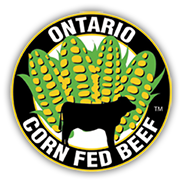
Ontario Corn Fed Beef is on the threshold of new growth opportunities as the program continues to make inroads in the market place.
Jim Clark, Executive Director of the Ontario Cattle Feeders’ Association, said various packing plants in the province are showing more interest in the farmer-owned brand.
Clark presented an update on the program to 13th annual Beef Industry Convention in London on Jan. 7. The presentation not only detailed the growth opportunities, it also identified several challenges.
Launched in 2001, the business model for the Corn Fed Beef program has been built on a production-to-plate scenario, in which producers, packers, retailers and distributors each have a significant investment in the model, particularly in food safety.
“After ten years, the market place is ready for this type of concept,” said Clark. “The silos that have existed in the past are slowly coming down,” he said, referring to the lack of collaboration that sometimes exists between the industry sectors.
Clark noted the OCFA is working with Cargill Meat Solutions in Guelph to develop business with some major retailers in Canada and the United States as well as in some specialty markets in the Pacific Rim.
He said the growing international demand has the potential to increase the number of cattle required for the program to 234,000 per year – or 4,500 per week – in approximately two years.
While the brand enjoys increased interest and good growth potential, Clark said the program faces a difficult task of meeting the growing demand. According to Clark, the biggest challenge is ensuring a steady supply of cattle for the Quality Assurance program.
“Our customers are not going to take the hills and the valleys,” said Clark. “If they sign onto the program, they want to be guaranteed that they have the cattle.”
On that note, Clark said the program needs more producers and cattle to meet its supply issues. To help attract more farmers to the program, Clark said the group is proposing the separate Ontario Corn Fed Beef Corporation to develop and manage a “Ledger Account” program.
Clark said the program is a financial tool to help producers deal with the inherent risk of the beef industry and bring a “systems approach” to ensuring a consistent supply of calves, feeder and fed cattle.
The OCFA submitted a request to the province to provide a one-time investment of $20 million (or a loan guarantee) to establish the program. Under the program, which has yet to receive a decision from OMAFRA, participating beef producers would receive a guarantee that production costs would be covered under a cost of production formula.
As he looks ahead to another year, Clark reminded farmers and the agriculture industry to embrace change as they take on future challenges.
“A more sustainable livestock and agricultural sector is the only way to meet the growing demand going into the future,” noted Clark. “We need government and industry to deliver new innovative programs that enhance agriculture and stimulate increased investment.”
